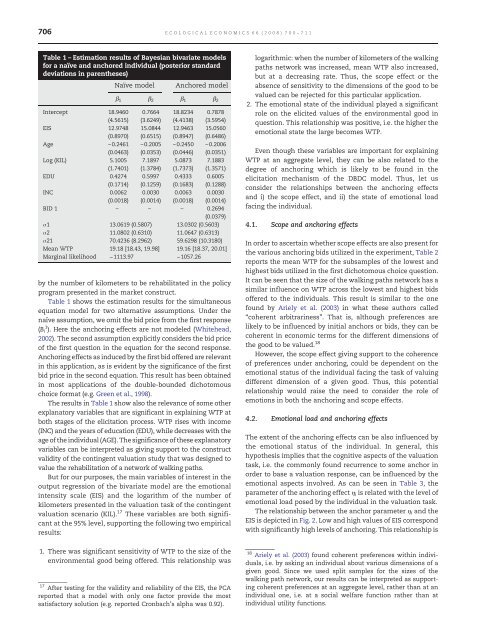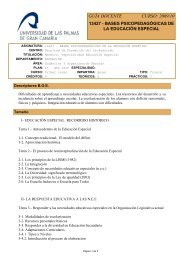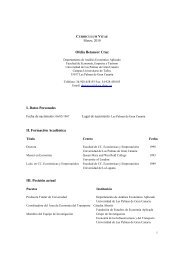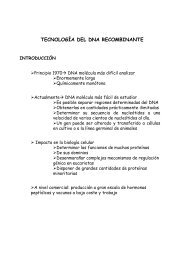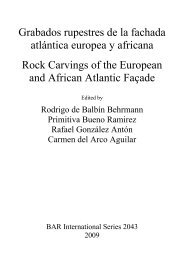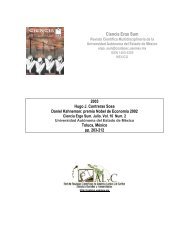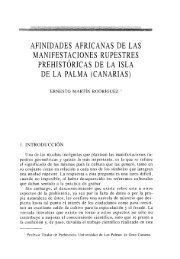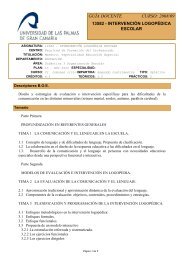ECOLOGICAL ECONOMICS 66 (2008) 700– 711705model with <strong>anchoring</strong> effects that allows us to consider theinterdependencies between the stages in the elicitation process.That is,WTP 1 i¼ A 1 iþ e 1 iWTP 2 i¼ A 2 iþ g i B 1 iþ e 2 iwith g i a½0; 1Š 8i; i ¼ 1; 2;:::nwhere μ i k =α i k +x i k β k (k=1,2) are the linear predictors associatedwith l×1 regression parameter vectors β k <strong>and</strong> covariate vectorsx i k , α i k is the intercept term, <strong>and</strong> η i captures the potential existenceof an anchor effect of the first bid on WTP of individual i(Herriges <strong>and</strong> Shogren, 1996). The linear predictors are linked tothe probability of a positive response by a bivariate normalcumulative distribution (BVN) called the link function. Simultaneitybetween responses is captured by the lower triangle componentof Σ (e.g. σ 2,1 ). This is a model of simultaneous equationswith limited dependent variables (SLDV), which reduces to ageneral triangular system (Zellner, 1971) for complete data sets.3.1. Inconsistency in elicited <strong>preferences</strong> between answers13 Alternatively, it would allow us to increase the precision of theestimates (lower variance) holding sample size constant.14 The inconsistency between first <strong>and</strong> second responses leads tothe rejection of the maintained assumption of the restricteddouble bounded model (Hanemann et al. 1991) that the mean <strong>and</strong>variances are constant across both bounds, <strong>and</strong> that the correlationcoefficient between the st<strong>and</strong>ard errors is equal to one,which essentially means that WTP i 1 =WTP i 2 . The rejection of thishypothesis implies a reduction in the efficiency gains of thedouble bounded elicitation procedure.15 The number of bounds can be increased successively in theelicitation process, leading to what has been denominated thetriple bounded dichotomous choice model (Langford et al. (1996).Cooper <strong>and</strong> Hanemann (1995) <strong>and</strong> Scarpa <strong>and</strong> Bateman (2000)showed that the efficiency gains are likely to diminish when thenumber of binary steps in the elicitation process is increased.ð1ÞThe main advantage of DBDC over SBDC is that the formerprovides more information on individual's <strong>preferences</strong>. Hanemannet al. (1991) showed that it leads to more efficient welfareestimates. This additional information may potentially allowthe researcher to conduct studies at a lower cost (smaller samplesizes) while holding the precision of the WTP estimates constant(same variance). 13 However, the DBDC has been questionedbecause of the empirical support to the argument that thedistribution of WTP is incoherent between both steps (e.g. Greenet al., 1998; Cameron <strong>and</strong> Quiggin, 1994). 14 In other words, themean or median WTP estimated using responses to the firstvaluation question differs empirically from the one estimatedusing the responses to the second question. 15The presence of potential behavioral responses to the followupquestion has been argued in non-market valuation as theprimary explanation of the incoherency between DBDC <strong>and</strong>SBDC (Alberini, 1995; Carson et al., 2001; Burton et al., 2003;DeShazo, 2002; Bateman et al., 2001). Innovative efforts to modeleconometrically some of the reactions to the second bid offeredcan be found in Cameron <strong>and</strong> Quiggin (1994), Herriges <strong>and</strong>Shogren (1996), Alberini et al. (1997), Whitehead (2002), Flachaire<strong>and</strong> Hollard (2006) <strong>and</strong> Araña <strong>and</strong> León (2007). Theargumentscommonly raised for explaining these behavioral responsesinclude <strong>anchoring</strong> effects, strategic behavior, yea-saying, neasaying,uncertainty cost, weighted average, bargaining, guilty/indignation <strong>and</strong> quality/quantity shift, among others. Forsimplicity, in this paper we focus on the <strong>anchoring</strong> effects,which can be seen as a general cognitive heuristic implicitlylinked to other behavioral responses.3.2. Anchoring effectsAn empirical result of the DBDC is the fact that, in follow-upquestion the distribution function of WTP could be influencedby precedent stage, implying some type of <strong>anchoring</strong> effect orbehavioral process (e.g. Herriges <strong>and</strong> Shogren, 1996; Aadl<strong>and</strong><strong>and</strong> Caplan, 2004). In a general setting, Tversky <strong>and</strong> Kahneman's(1974) describe the <strong>anchoring</strong> effect as “the process inwhich people make estimates by starting from an initial valuethat is adjusted to yield a final answer.”Following previous models of DBDC (Herriges <strong>and</strong> Shogren,1996; Whitehead, 2002), our model collects the influence of thestarting bid amount on WTP in the term η i B i1 . Parameter η imeasures the importance of the anchor effect of the first bidon WTP at an individual level. Thus, the <strong>anchoring</strong> effecthypothesis may be tested for each individual of the sample byconsidering these two alternatives: H 0 : η i =0; <strong>and</strong> H 1 : no H 0 .3.3. The econometric modelIn order to estimate the model, we utilize a Bayes approach(Chib, 1992; Albert <strong>and</strong> Chib, 1993), similar to the one applied byAraña <strong>and</strong> León (2005). 16 This approach has basically three mainadvantages over st<strong>and</strong>ard maximum likelihood estimation: i) itallows for more flexibility <strong>and</strong> unobserved heterogeneity in themodel through the r<strong>and</strong>om parameters specification; ii) itallows for an easy <strong>and</strong> efficient comparison between modelsthrough the use of the Bayes Factor; iv) it relies on an exacttheory of probability even with small samples, leading to moreaccurate results in this context. The detailed description of theeconometric model <strong>and</strong> the components of the Bayesianapproach are explained in detailed in the Appendix A.4. ResultsThe estimation of the simultaneous equation model outlinedin the previous section is particularly intended to raise furtherevidence on the <strong>anchoring</strong> effects produced by the first bidprices offered in the double-bounded dichotomous choicemodel. Although this model centers on <strong>anchoring</strong> effects, thedata collected in our field experiment also allows us toinvestigate i) the potential relationships between <strong>anchoring</strong>effects <strong>and</strong> the emotional state of the individual, <strong>and</strong> ii) thepotential relationships between <strong>anchoring</strong> effects <strong>and</strong> thescope of the environmental good to be valued, as represented16 In order to test the sensitivity of the results to the econometricapproach, maximum likelihood estimations of a bivariate probitmodel have been carried out. The results show no significantdifferences in terms of the hypotheses proposed in this study.The sensitivity analysis results, data set <strong>and</strong> the GAUSS programcodes for the Bayesian estimation are available from the authorsupon request.
706 ECOLOGICAL ECONOMICS 66 (2008) 700– 711Table 1 – Estimation results of Bayesian bivariate modelsfor a naïve <strong>and</strong> anchored individual (posterior st<strong>and</strong>arddeviations in parentheses)Naïve model Anchored modelIntercept 18.9460(4.5615)EIS 12.9748(0.8970)Age −0.2461(0.0463)Log (KIL) 5.1005(1.7401)EDU 0.4274(0.1714)INC 0.0062(0.0018)β 1 β 2 β 1 β 20.7664(3.6249)15.0844(0.6515)−0.2005(0.0353)7.1897(1.3784)0.5997(0.1259)0.0030(0.0014)18.8234(4.4138)12.9463(0.8947)−0.2450(0.0446)5.0873(1.7373)0.4333(0.1683)0.0063(0.0018)0.7878(3.5954)15.0560(0.6486)−0.2006(0.0351)7.1883(1.3571)0.6005(0.1288)0.0030(0.0014)BID 1 – – – 0.2694(0.0379)σ1 13.0619 (0.5807) 13.0302 (0.5603)σ2 11.0802 (0.6310) 11.0647 (0.6313)σ21 70.4236 (8.2962) 59.6298 (10.3180)Mean WTP 19.18 [18.43, 19.98] 19.16 [18.37, 20.01]Marginal likelihood −1113.97 −1057.26by the number of kilometers to be rehabilitated in the policyprogram presented in the market construct.Table 1 shows the estimation results for the simultaneousequation model for two alternative assumptions. Under thenaïve assumption, we omit the bid price from the first response(B i 1 ). Here the <strong>anchoring</strong> effects are not modeled (Whitehead,2002). The second assumption explicitly considers the bid priceof the first question in the equation for the second response.Anchoring effects as induced by the first bid offered are relevantin this application, as is evident by the significance of the firstbid price in the second equation. This result has been obtainedin most applications of the double-bounded dichotomouschoice format (e.g. Green et al., 1998).The results in Table 1 show also the relevance of some otherexplanatory variables that are significant in explaining WTP atboth stages of the elicitation process. WTP rises with income(INC) <strong>and</strong> the years of education (EDU), while decreases with theage of the individual (AGE). The significance of these explanatoryvariables can be interpreted as giving support to the constructvalidity of the contingent valuation study that was designed tovalue the rehabilitation of a network of walking paths.But for our purposes, the main variables of interest in theoutput regression of the bivariate model are the emotionalintensity scale (EIS) <strong>and</strong> the logarithm of the number ofkilometers presented in the valuation task of the contingentvaluation scenario (KIL). 17 These variables are both significantat the 95% level, supporting the following two empiricalresults:logarithmic: when the number of kilometers of the walkingpaths network was increased, mean WTP also increased,but at a decreasing rate. Thus, the scope effect or theabsence of sensitivity to the dimensions of the good to bevalued can be rejected for this particular application.2. The emotional state of the individual played a significantrole on the elicited values of the environmental good inquestion. This relationship was positive, i.e. the higher theemotional state the large becomes WTP.Even though these variables are important for explainingWTP at an aggregate level, they can be also related to thedegree of <strong>anchoring</strong> which is likely to be found in theelicitation mechanism of the DBDC model. Thus, let usconsider the relationships between the <strong>anchoring</strong> effects<strong>and</strong> i) the scope effect, <strong>and</strong> ii) the state of emotional loadfacing the individual.4.1. Scope <strong>and</strong> <strong>anchoring</strong> effectsIn order to ascertain whether scope effects are also present forthe various <strong>anchoring</strong> bids utilized in the experiment, Table 2reports the mean WTP for the subsamples of the lowest <strong>and</strong>highest bids utilized in the first dichotomous choice question.It can be seen that the size of the walking paths network has asimilar influence on WTP across the lowest <strong>and</strong> highest bidsoffered to the individuals. This result is similar to the onefound by Ariely et al. (2003) in what these authors called“coherent arbitrariness”. That is, although <strong>preferences</strong> arelikely to be influenced by initial anchors or bids, they can becoherent in economic terms for the different dimensions ofthe good to be valued. 18However, the scope effect giving support to the coherenceof <strong>preferences</strong> <strong>under</strong> <strong>anchoring</strong>, could be dependent on theemotional status of the individual facing the task of valuingdifferent dimension of a given good. Thus, this potentialrelationship would raise the need to consider the role of<strong>emotions</strong> in both the <strong>anchoring</strong> <strong>and</strong> scope effects.4.2. Emotional load <strong>and</strong> <strong>anchoring</strong> effectsThe extent of the <strong>anchoring</strong> effects can be also influenced bythe emotional status of the individual. In general, thishypothesis implies that the cognitive aspects of the valuationtask, i.e. the commonly found recurrence to some anchor inorder to base a valuation response, can be influenced by theemotional aspects involved. As can be seen in Table 3, theparameter of the <strong>anchoring</strong> effect η i is related with the level ofemotional load posed by the individual in the valuation task.The relationship between the anchor parameter η i <strong>and</strong> theEIS is depicted in Fig. 2. Low <strong>and</strong> high values of EIS correspondwith significantly high levels of <strong>anchoring</strong>. This relationship is1. There was significant sensitivity of WTP to the size of theenvironmental good being offered. This relationship was17 After testing for the validity <strong>and</strong> reliability of the EIS, the PCAreported that a model with only one factor provide the mostsatisfactory solution (e.g. reported Cronbach's alpha was 0.92).18 Ariely et al. (2003) found coherent <strong>preferences</strong> within individuals,i.e. by asking an individual about various dimensions of agiven good. Since we used split samples for the sizes of thewalking path network, our results can be interpreted as supportingcoherent <strong>preferences</strong> at an aggregate level, rather than at anindividual one, i.e. at a social welfare function rather than atindividual utility functions.


